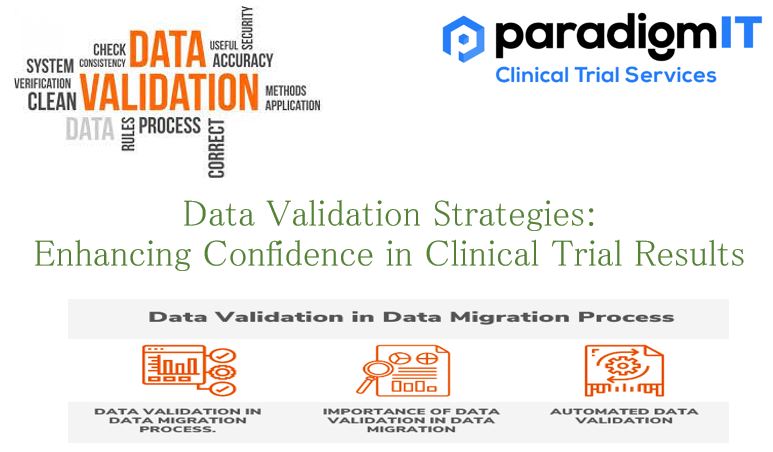Data validation refers to the process of ensuring the accuracy and quality of data. It is implemented by building several checks into a system or report to ensure the logical consistency of input and stored data.
Types of Data Validation
- Data Type Check
A data type check confirms that the data entered has the correct data type. For example, a field might only accept numeric data. If this is the case, then any data containing other characters such as letters or special symbols should be rejected by the system.
- Predetermined Values List Validation
A code check ensures that a field is selected from a valid list of values or follows certain formatting rules. For example, it is easier to verify that a list of valid codes against entered/selected data for “Action Taken” for AE reported.
- Range Check
A range check will verify whether input data falls within a predefined range. For example, Vital Signs value should be between -global standards for upper and lower limits to identify the patient health risks
- Format Check
Many data types follow a certain predefined format. A common use case is date columns that are stored in a fixed format like “YYYY-MM-DD” or “DD-MM-YYYY.” A data validation procedure that ensures dates are in the proper format helps maintain consistency across data and through time.
- Consistency Check
A consistency check is a type of logical check that confirms the data’s been entered in a logically consistent way. An example is checking if the delivery date is after the shipping date for a parcel.
- Uniqueness Check
Some data like IDs or e-mail addresses are unique by nature. A database should likely have unique entries on these fields. A uniqueness check ensures that an item is not entered multiple times into a database.
Reactive vs Proactive Validation techniques:
The purpose of any data validation is to identify where data might be inaccurate, inconsistent, incomplete, or even missing.
Reactive data validation takes place after the fact and uses anomaly detection to identify any issues your data may have and to help ease the symptoms of bad data. While these methods are better than nothing, they don’t solve the core problems causing the bad data in the first place.
Instead, we believe teams should try to embrace proactive data validation techniques for their analytics, such as type safety and schematization, to ensure the data they get is accurate, complete, and in the expected structure (and that future team members don’t have to wrestle with bad analytics code).
Reasons why Proactive Data Validation is Required:
- Data validation should be part of the Software Development Life Cycle (SDLC)
- Proactive data validation can be integrated into your existing tools.
- Proactive data validation testing is one of the best ways fast-moving teams can operate efficiently. It ensures they can iterate quickly and avoid data drift and other downstream issues.
- Proactive data validation gives you the confidence to change and update your code as needed while minimizing the number of bugs you’ll have to squash later. This proactive process ensures you and your team are only changing the code that’s directly related to the data you’re concerned with.
Implementing proactive data validation methods in clinical trials involves a combination of strategies to anticipate, prevent, and address potential data issues. Here are some suggested methods for proactive data validation:
- Real-time Data Monitoring using Automated Data Checks: Utilize electronic data capture (EDC) systems or other technologies to monitor data entry and perform real-time validation checks. This can include implementing automated range checks, logical checks, and consistency checks to identify potential errors or inconsistencies as data is being collected. To achieve it develop a comprehensive data validation plan as part of the overall study protocol. This plan should outline the specific data validation processes, including the types of checks, the frequency of review, and the criteria for resolution of discrepancies.
- Risk-Based Data Review: Focus on critical data elements and high-risk areas based on a risk assessment of the study. Allocate resources and prioritize data review efforts to areas with a higher likelihood of data quality issues. This targeted approach ensures that potential problems are addressed early and effectively.
- Data Sampling and Quality Control: Conduct regular sampling of the data to assess its quality. This involves reviewing a subset of the data to identify errors, inconsistencies, or missing values. Quality control measures can be implemented to ensure that data meets predefined quality standards.
- Independent Data Review and Cross Functional Team Meetings: Engage independent experts or statisticians to review the data periodically. Their objective analysis can identify potential issues, biases, or data quality concerns that may have been overlooked. Independent reviews provide an additional layer of validation and enhance confidence in the trial results. These meetings facilitate open communication and collaboration, ensuring that data validation remains a priority throughout the study.
- Training and Education: Provide ongoing training and education to study personnel (Site staff and Service provider) involved in data collection, entry, and validation. This includes reinforcing the importance of data quality, training on data validation procedures, and promoting a culture of proactive data management.
- External Data Monitoring Committee: Establish an external data monitoring committee comprising independent experts to oversee data validation processes. The committee can provide guidance, review data quality reports, and make recommendations for improving data validation efforts.
- Continuous Process Improvement: Continuously evaluate and improve data validation processes based on lessons learned and feedback from previous studies. Identify areas of improvement and implement changes to enhance the effectiveness and efficiency of data validation.
By implementing these proactive data validation methods, clinical trial researchers can detect and address potential data issues early, leading to improved data quality, reliability, and ultimately, confidence in the trial results.
For more information –
Visit our website – www.paradigmit.com
Or you can write us at ask@paradigmit.com
Follow us for more – https://www.linkedin.com/company/paradigmittechnologyservices/?viewAsMember=true


